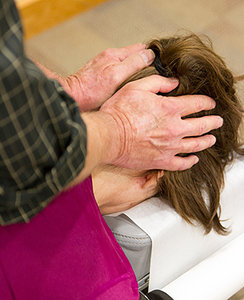Editor's Note: This article is a follow-up to "A Chiropractic Solution for Mouse Shoulder" (October issue), which also explored technology-related pain and dysfunction, and specific chiropractic adjustments that can be beneficial.
With the widespread use of mobile devices such as smartphones and tablets, the incidence of "text neck" has reached almost epidemic proportions.
A major cause of chronic cervical extension is inferior fixation of the posterior occiput, sometimes called anterior-superior (AS) occiput. Hypertonicity of suboccipital muscles and forward jutting of the face – "chin poke" – are frequently encountered in patients who spend a large part of their day using electronic devices.
Desktop computers and work stations, as well as fixed-position laptops, are prime examples of such equipment. (Users of smartphones and tablets may also demonstrate similar postural distortions of the cervical spine and occiput.)
Upper Crossed Syndrome
One signature feature of the condition – also known as "upper crossed syndrome" – is the tendency of the patient to jut the face and chin forward while rising from a sitting position. Posture analysis also helps to identify upper crossed syndrome in affected patients. The lateral view of the patient typically shows increased thoracic kyphosis, anterior carriage of shoulder and upper torso muscles, neck flexion (especially C2-C6), and a generally slumped posture.
 The external auditory meatus is almost always well to the anterior of a plumb line running down through the deltoid tubercle, the crest of the ilium, and the knee to the lateral malleolus. The inferior jaw line slopes up and forward so the chin is anterior to the normal plane of the face. This is what clinicians such as Dr. Marc Heller and other researchers have described as chin poke.1
The external auditory meatus is almost always well to the anterior of a plumb line running down through the deltoid tubercle, the crest of the ilium, and the knee to the lateral malleolus. The inferior jaw line slopes up and forward so the chin is anterior to the normal plane of the face. This is what clinicians such as Dr. Marc Heller and other researchers have described as chin poke.1
It has also been suggested that AS occiput is a biomechanical righting reflex that tells a person to look up so they are looking straight ahead, especially when rising from a sitting position. The chin poke is a part of that reflex and a biomechanical manifestation of upper crossed syndrome.
Presenting Symptoms, Potential Complications and Exam Findings
Some of the principal complaints that bring patients with upper crossed syndrome to the chiropractic clinic include neck pain and stiffness, cervicogenic headaches and fatigue. Over the long haul, because of forward head bearing, there may be an increased risk of cervical disc pathology, degenerative joint disease, muscle weakness in the upper back, and ischemia of upper extremities with dysesthesia in the hands and fingers.2
Several writers contend that slumping posture, especially while sitting, inevitably leads to hypertonicity of anterior neck muscles including the scalenes, sternocleidomastoids and pectoralis major.3-5 Therefore, extension malposition with anterior fixation of the occiput does not just affect the cervical region, but rather the entire spine and related structures.
Examination findings include suboccipital muscle hypertonicity with trigger points along the inferior margin of the base of the skull. Often the patient can indicate the most tender sites in the neck by pointing to them. Tender points, Dr. Heller observes, provide effective pre- and post-adjustment assessment. He goes on to note that tender points or trigger points located more medially indicate atlanto-occipital or dural involvement, while more lateral trigger points are consistent with fixation of C1 or SCM muscle hypertonicity.
Reduced posterior glide of the occiput relative to atlas (extension fixation) is also a frequent finding in the affected patient. To test for reduced posterior glide on the supine patient, stand at the head of the table and gently flex the head forward (passively tuck the chin). If there is resistance to this maneuver, the occiput is in extension malposition – which Dr. Heller notes is consistent with the "chin poke" phenomenon, a posture frequently observed in users of electronic devices.
 AS Occiput Adjustment
Adjusting the AS Occiput
AS Occiput Adjustment
Adjusting the AS Occiput
The primary intent of the AS occiput adjustment is to lift the occiput away from extension fixation, release hypertonicity of the suboccipital musculature and return the head to its neutral position. To adjust the AS occiput,6-7 use a table equipped with a drop headpiece. If the headpiece can be deflected, angle it inferiorly about 10 degrees. Table tension should be set for minimal resistance.
Assume a scissors stance on either side of the patient at the level of the upper humerus. When a patient demonstrates head tilt, stand on that side. Reach across the patient to take a bilateral thenar contact at the superior nuccal line, just lateral and inferior to the external occipital protuberance. Ask the patient to tuck the chin briefly and slide the contact hands up, taking a tissue pull on the inferior nuccal line.
Ask the patient to relax the head back against the contact hands, in effect preloading the occiput prior to the thrust. The thrust is mainly inferior-to-superior (I-S) and slightly posterior-to-anterior to maintain contact.
Clinical Considerations
Because paraspinal muscles and periarticular soft tissue are likely to be distressed, warn the patient that the adjustment could cause transient irritation. Also, post-checks immediately following the adjustment may yield little useful information. A meaningful assessment of the outcome of care is best conducted with a follow-up visit. It may also be advantageous to incorporate upper crossed syndrome rehabilitative exercises into the treatment protocol.
References
- Heller M. "The Upper Cervical Spine – The Occiput." Dynamic Chiropractic, Dec. 14, 2001.
- Hansraj KK. Assessment of stresses in the cervical spine caused by posture and position of the head. Surg Technol Int, 2014;25:277-9.
- Heller M. "Cervical Muscles and Postural Balance." Dynamic Chiropractic, July 1, 2002.
- Miller K. "Upper Crossed Syndrome: Identifying and Applying Movement Strategies for Improved Posture." American Fitness Magazine, Fall 2016.
- Tucker J. "Posture Evaluations (Part 2): Forward Head and Forward Shoulder." Dynamic Chiropractic, June 17, 2010.
- Zemelka WH. Segmental Drop Adjusting. Davenport, IA: Multiple Interest Services Corp., 2004.
- Hyman RC. Table Assisted Adjusting: An Exposition of the Thompson Technique, 2nd Edition. Dallas: Enchantment Publishing, 1995.
Dr. Howard Pettersson, a 1976 graduate of Logan College of Chiropractic, is an associate professor of technique at Palmer College of Chiropractic. He was the senior editor of Activator Methods Chiropractic Technique – College Edition, published in 1989, and published Pelvic Drop Table Adjusting Technique in 1999. His most recent publication, written with Dr. Green, is How to Find a Subluxation, published in 2003.
Dr. J.R. Green is a 1988 Graduate of Palmer College of Chiropractic. He retired from the Palmer faculty after many years of teaching basic sciences and chiropractic technique. He is currently in private practice in Galva, Ill., and is also an adjunct professor of chemistry with the Eastern Iowa Community College District. Dr. Green was one of the writers of Activator Methods Chiropractic Technique (1997) and also worked as a technical writing consultant on Activator Methods Chiropractic Technique – College Edition and Pelvic Drop Table Adjusting Technique.




